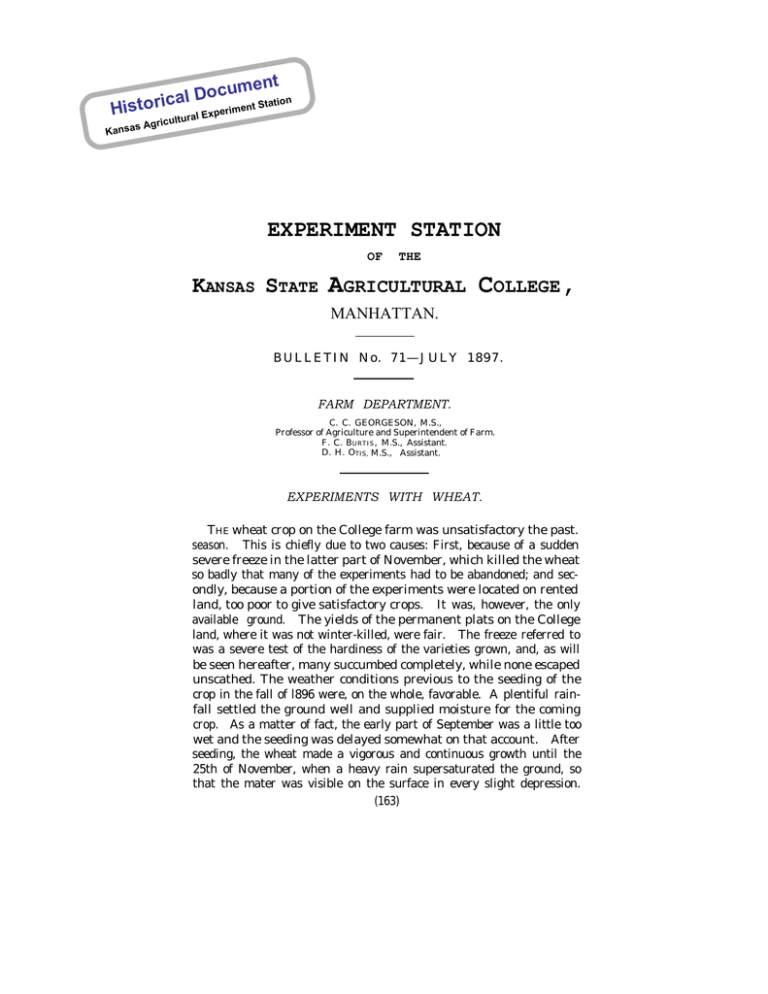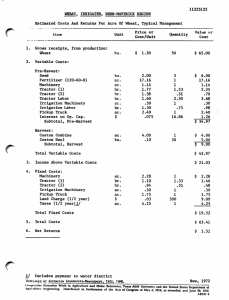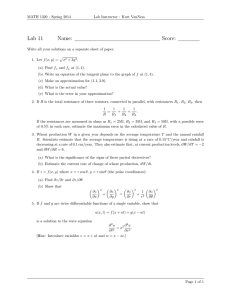A C , EXPERIMENT STATION
advertisement

ument l Doc storica Hi riment Expe ultural Station s Agric Kansa EXPERIMENT STATION OF THE KANSAS STATE AGRICULTURAL COLLEGE, MANHATTAN. BULLETIN No. 71—JULY 1897. FARM DEPARTMENT. C. C. GEORGESON, M.S., Professor of Agriculture and Superintendent of Farm. F. C. BURTIS , M.S., Assistant. D. H. OTIS, M.S., Assistant. EXPERIMENTS WITH WHEAT. THE wheat crop on the College farm was unsatisfactory the past. season. This is chiefly due to two causes: First, because of a sudden severe freeze in the latter part of November, which killed the wheat so badly that many of the experiments had to be abandoned; and secondly, because a portion of the experiments were located on rented land, too poor to give satisfactory crops. It was, however, the only available ground. The yields of the permanent plats on the College land, where it was not winter-killed, were fair. The freeze referred to was a severe test of the hardiness of the varieties grown, and, as will be seen hereafter, many succumbed completely, while none escaped unscathed. The weather conditions previous to the seeding of the crop in the fall of l896 were, on the whole, favorable. A plentiful rainfall settled the ground well and supplied moisture for the coming crop. As a matter of fact, the early part of September was a little too wet and the seeding was delayed somewhat on that account. After seeding, the wheat made a vigorous and continuous growth until the 25th of November, when a heavy rain supersaturated the ground, so that the mater was visible on the surface in every slight depression. (163) ument l Doc storica Hi riment Expe ultural Station s Agric Kansa 164 Farm Department. [Bulletin 71 This rain was immediately followed by a cold wave which continued several days, and during which the ground froze 8 to 10 inches deep. This was too much for all but a few of the hardiest varieties, and even these suffered severely in places. During the rest of the winter the conditions were favorable to the wheat crop, and regions which were not flooded previous to the cold rain of November did not suffer from winter-killing. As a consequence, there were large areas in the state, especially in the south and west, where the wheat crop has been unusually good the past season. In May our wheat suffered slightly for lack of rain, while chinch-bugs and rust appeared to decrease the yield. In the middle of June several days of dry, hot winds, just as the wheat was filling, hastened the ripening prematurely, and caused a shrinking of the berry in all but the earliest varieties, like the Zimmerman, in which the berry was full-grown when the hot weather began. The following series of experiments were undertaken: I. WHEAT CONTINUOUSLY WITHOUT MANURE II. WHEAT ON SUBSOILED AND SURFACE-PLowED LAND. III. TIME OF SEEDING WHEAT. IV. WHEAT IN ROTATION. V. TEST OF V ARIETIES . VI. E FFECTS OF P ASTURING W HEAT . VII. METHODS OF SEEDING WHEAT. VIII. E FFECT OF G RADING S EED . IX. S EEDING AT D IFFERENT R ATES PER A CRE . X. W HEAT ON E ARLY- AND L ATE -P LOWED L AND . Of these 10 series of experiments, the five last named suffered so much from the causes above referred to that they had to be abandoned completely. The first five named gave results which are of some interest and which are detailed in what follows. I. “THE EXPERIMENTAL ACRE.” As for 16 years previous to the present crop, this acre has been sown in wheat year after year without manure, the object being to test the ability of the soil to sustain continuous wheat crops. It is unfortunate that the projector of this exceedingly interesting experiment located it on sloping ground. In addition to the natural exhaustion of plant food, due to continual cropping, it undoubtedly also loses fertility by washing. When a heavy rain happens to fall while the soil is loose, considerable quantities of the surface soil are carried to the lower edge of the inclosure, where most of it is deposited, while a portion is carried outside. Washings of this character had last year ument l Doc storica Hi riment Expe ultural Station s Agric Kansa perceptibly raised the level of the lower side of the acre. To remedy the evil as far as possible, the earth was hauled back and scattered over the surface from whence it was removed, but this, of course, is only a partial remedy. With the foregoing exception, the treatment of the acre the past year has been similar to that of former years in all respects. It was plowed to the depth of eight inches on the 22d day of July, and harrowed to subdue weeds on July 23, August 4, August 26, September 2, and just before seeding on September 24. It was seeded with a shoe-press drill with 1.25 bushels of Currell wheat on the 24th of September. The growth was satisfactory up to the 25th of November, when the storms and subsequent severe freeze already referred to almost completely killed the crop. The yield is given in the accompanying table. It will be seen that it amounts to less than 4.5 bushels, and this of an inferior quality of wheat. The table further shows, that of the 17 years in which this acre has been cropped continuously with wheat there have been three complete failures from winter-killing, while the crops harvested in 1894 and 1897 were but little short of failures, owing to the same cause; but in spite of these light crops the average yield per acre for the 14 crops which have been harvested is 23.76 bushels, which is above the average yield of the state in any year during the same period. ument l Doc storica Hi riment Expe ultural Station s Agric Kansa II.—SUBSOILING vs. SURFACE-PLOWING FOB WHEAT. SERIES I. To test the value of subsoiling again, eight plats were measured off in the Williston field, and the alternating ones subsoiled August 3 and 4,1896, with the Secretary plow to the depth of 17 to 18 inches. It was very hard work for six large horses to pull the plow at this depth. The remaining plats were plowed with a sulky plow to the depth of 8 inches on the land side August 5, after which all plats were harrowed to level the surface. Heavy rains about the 20th of the month settled the soil well, and all plats were again harrowed August 27, and again September 5. All plats were seeded September 23 with a shoe-press drill at the rate of 1.5 bushels of Turkey wheat per acre. The ground being in excellent condition and full of moisture, the wheat came up promptly and made a moderate growth before the cold weather which occurred the last of November. The Turkey wheat, being a very hardy variety, suffered but little from the severe freeze, and the mild weather in December caused the wheat to make a slight growth. The hot, dry winds which occurred about the middle of June struck the wheat with the kernels in the milk and it prevented their filling out to normal size. The crop was ripe and harvested June 23, with the results as shown in table II. It will be noticed that the subsoiled plats gave in every instance lighter yields than the immediately adjoining surface-plowed plats, and that the average yield of the subsoiled plats is but 12.67 bushels per acre, while the surface-plowed plats yielded 15.39 bushels. In this case we cannot avoid the conclusion that the heavy and expensive work of subsoiling these plats caused a positive loss in yield of wheat. ument l Doc storica Hi riment Expe ultural Station s Agric Kansa July 1897.] Experiments with Wheat. 167 SUBSOILING vs. SURFACE-PLOWING. SERIES II. This experiment is a continuation of the one recorded on pages 93 and 94 of bulletin 59. It was repeated for the present crop only to see if the subsoiling would show any effect at this date. The 10 plats were set aside for permanent experimentation in the summer of 1894, when five were subsoiled and five surface-plowed, and all seeded to wheat. The wheat was completely winter-killed; so the experiment had to be abandoned. In the spring of 1895 all plats were surface-plowed and planted to field peas. The pea crop was harvested in July, and immediately after all plats were again surface-plowed, in preparation for wheat. They were seeded to Zimmerman wheat September 17, 1895. The crop which was harvested in 1896 showed an average yield of half a bushel per acre less on the subsoiled plats than on the surface-plowed plats. For the present crop all plats were surface-plowed to the depth of about eight inches on July 25, 1896, and seeded September 26 with Zimmerman wheat at the rate of 1.5 bushels per acre with a shoepress drill. The stand was good and the growth satisfactory. The crop suffered somewhat from the vicissitudes already detailed, but the Zimmerman being a hardy wheat, the injury was only partial, though it caused a somewhat irregular stand. The subsoiled plats proved to have a poorer stand in the spring than the surface-plowed plats. This was so generally the case that it is hard to avoid the conclusion that it was due to the subsoiling. The results are shown in table III, which shows that the average yield is nearly four bushels better on the surface-plowed plats than on the subsoiled ones. Our experience with subsoiling, both for wheat and corn (see bulletin 64), indicates that there is a positive loss, not only of labor but of yield, by subsoiling here on the College farm. ument l Doc storica Hi riment Expe ultural Station s Agric Kansa Farm Department. 168 [Bulletin 71 SUMMARY OF AVERAGES FOR TWO YEARS. Rate of yield per acre, in bushels. General average. TREATMENT. Subsoiled Surface-plowed .... . . . . . . . . III.TIME OF SEEDING WHEAT. A series of 50 plats was laid out in a rented field belonging to the Williston estate. The soil is poor and not uniform in quality. Ten seedings were made one week apart, beginning with August 31. All plats were seeded with Zimmerman wheat with a shoe-press drill at the rate of 1.5 bushels per acre. All seedings after October 5 were completely winter-killed and the seeding of that date did not fall far short of the same fate. All plats were harvested June 19, with the results as shown in table IV. The poverty of the soil on which a portion of the plats was located is plainly indicated by the yields, but aside from this it will be noticed that there is a marked agreement in the yields for each date. The seedings made from the 7th to the 21st of September gave, as a rule, the best returns, and in the average it will be seen that the seedings made September 16 made the best showing, which agrees closely with the results of last year. The unfortunate winter-killing leaves us no data for seeding later than October 5, but it is evident that for this region wheat should be seeded the third week of September, under ordinary conditions. The results of all our experiments on this point afford scarcely an exception to this rule. IV.WHEAT IN ROTATION. The rotation experiments which were begun in 1890‘91 have been described in detail in several previous bulletins, and therefore do not require description again in the present bulletin, Table V shows the cropping of each of the 50 plats each year from the beginning. The figures given in the table indicate the yield of wheat in bushels per acre for the year, and plat noted. The past year all these plats were plowed July 23, and seeded to Zimmerman wheat with a shoe-press drill at the rate of 1.5 bushels per acre on September 26. None of the plats suffered from winter-killing to any extent, and the crop was generally satisfactory, except for some slight damage by rust and chinch-bugs, in which all plats partook alike. The yields are indicated in the table in the column headed “1897.” The experiment has not progressed far enough to speak with certainty in regard to the ument l Doc storica Hi riment Kansa s Agric Expe ultural Station ument l Doc storica Hi riment Expe ultural Station s Agric Kansa Farm Department. 170 [Bulletin 71 best rotation for this region, which would require a consideration of the value as well as the cost of production of all crops harvested on each particular plat during the rotation. Data are kept on these points and can be summarized for comparison when sufficient facts have been accumulated. Table V. WHEAT IN ROTATION. SERIES I. Plats, one-tenth of an acre. The figures given apply to the yield of wheat only. Rate of yield of grain per acre, in bushels. ROTATION . Total ave. 1897. 1896. 1895. 1894. 1890. 1890. ument l Doc storica Hi riment Expe ultural Station s Agric Kansa July 1897.] Experiments with Wheat. 171 WHEAT IN ROTATION. SERIES II. Another experiment, comprising 20 one-tenth-acre plats, has been started with a view to test the value of certain leguminous plants as fertilizers for the wheat crop. These plants are soy-beans, cow-peas, and field peas. These leguminous crops are grown partly as a catch-crop and partly as a rotation, in accordance with following plan: Thus, plat 51, and every fifth succeeding plat, is planted with soy-beans immediately after the wheat is harvested, and about the middle of September, when time to seed the wheat, the beans are mowed and cured for hay, and the wheat planted in the stubble without further preparation of the ground. Plat 52, and every fifth plat thereafter, is likewise planted to soy-beans in the wheat stubble, but instead of being harvested, the beans are plowed under before the wheat is seeded. Plat 53, and those similarly treated, are planted with cow-peas on the wheat stubble and these are cut and cured for hay and the wheat drilled in the stubble. Plat 54 is likewise sown to cow-peas and the crop is plowed under just before wheat seeding. Plat 55 and every fifth succeeding plat rotate wheat with beans and peas. Soy-beans are planted in the wheat stubble and harvested in the fall. Early the following spring Canadian field peas are sown on the same plat. This crop matures in June, when the plat is again immediately planted to soy-beans, which are harvested just before the wheat is seeded again in September. We have results for only one year. These are given in table VI. ument l Doc storica Hi riment Expe ultural Station s Agric Kansa 172 FarmDepartment [Bulletin 71 V.TEST OF VARIETIES. Interest in the variety test the past year centers chiefly in the fact that, while all varieties suffered by the freeze in November, some suffered more than others. The table shows the estimated per cent. of stand and the actual yield of those varieties which produced enough to make it worth while to harvest them. The blank places in the table indicate that the varieties to which they refer were either completely winter-killed or the yield so small that it was not worth harvesting. The figures given indicate the weight of grain and straw per plat and the rate of yield per acre in bushels of grain and tons of straw. It will be seen from this that there were comparatively few varieties hardy enough to withstand the severe test of the past winter. It should be noted further that the soil was poor and that the yield is, therefore, light for the per cent. of stand. The plats were, however, quite uniform in the quality of the soil. ument l Doc storica Hi riment Kansa s Agric Expe ultural Station ument l Doc storica Hi riment Expe ultural Station s Agric Kansa 174 [Bulletin 71 SUMMARY. 1. Wheat grown continuously without manure on a measured acre, for 17 years in succession, has produced an average yearly yield of 19.57 bushels. The crop was completely winter-killed during three of these years, so that only 14 crops were harvested, and two of them were partly winter-killed. The average yield of the 14 crops harvested is 23.76 bushels. 2. Subsoiling for wheat has not benefited the yield. It has, on the contrary, apparently reduced the yield over that on surface-plowed ground in nearly every instance it has been tried. 3. As to the time of seeding wheat, the results of the past season’s experiments confirm those of former years. The best yields were obtained from seedings made about the third week in September. 4. The rotation experiments are just beginning to give results, though they have not run long enough as yet to warrant definite conclusions. They do show, however, that a yearly application of 20 tons of barn-yard manure to the acre is decidedly detrimental, in that it causes an excessive growth of straw and a failure to develop kernel. 5. The rotation experiments in which wheat is followed by some leguminous catch-crop, sown as soon as the wheat is harvested and removed or plowed under in time to again sow the ground to wheat that same fall, have only just been begun, the past year being the only season in which wheat has been grown on this plan. The wheat seeded on soy-bean stubble gave the best yields. 6. The test of varieties is of special interest the present year, in that it shows the comparative hardiness of some 50 leading varieties grown at the Station for several years. Out of the whole number, only the Turkey, Tasmanian Red and Crimean withstood the severe freeze in November so as to yield at the rate of 10 bushels or more per acre.






